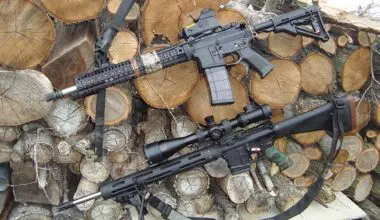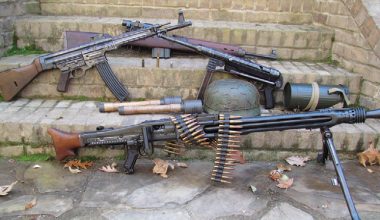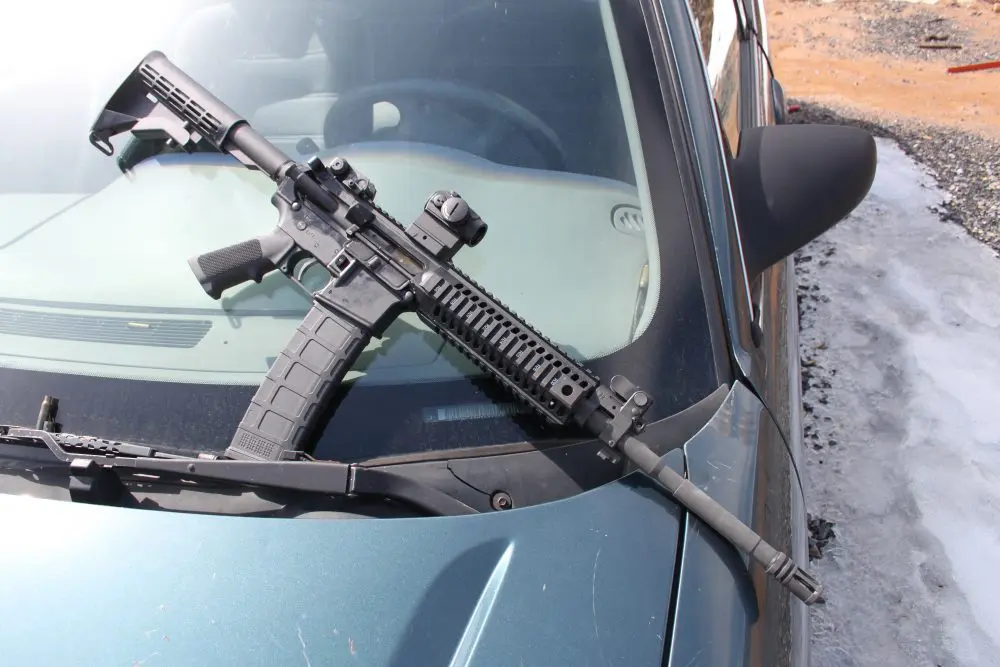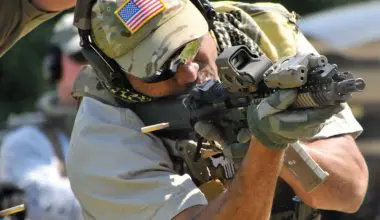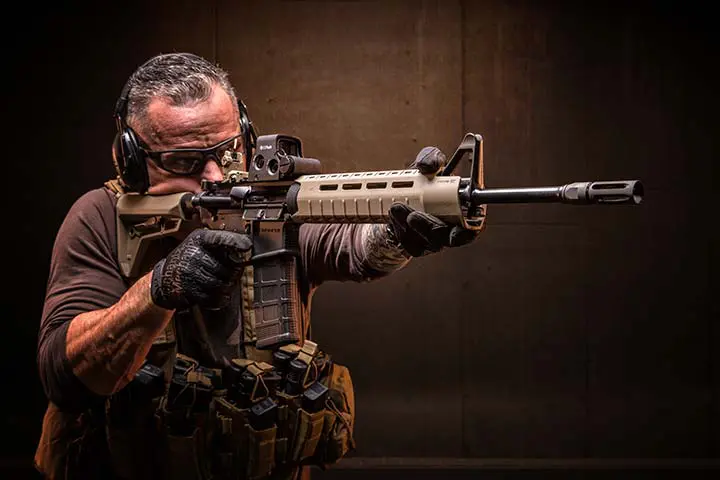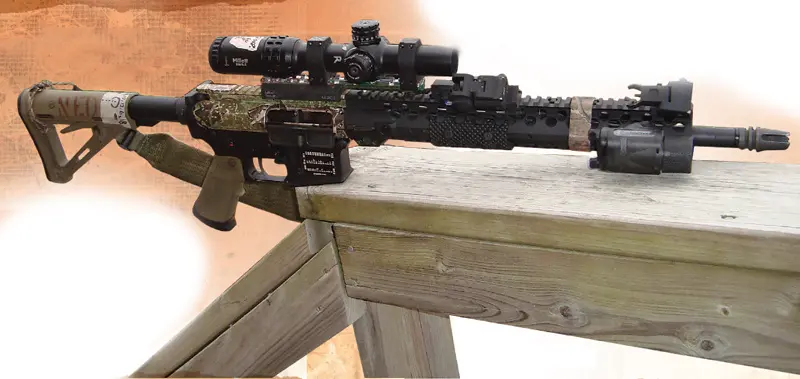
Gunwriters’ credibility is sometimes called into question when they have only good things to say about the guns and gear they review. As a freelance writer, I am generally not given assignments. I have the luxury of testing what I want to, when I think it may be of benefit to readers and students. I write it up and hope it makes it into print, and yes, I have returned products to manufacturers and politely told them it was useless. When there’s not enough time and page space to cover what’s worthy, why use any of it on the inadequate,irrelevant, and uninteresting?
Sometimes by chance, sometimes by design, I find I have accumulated almost enough parts, gear, accessories, and ammo to comprise a report. I scout new products that may be of interest to fill in the gaps, and I borrow or buy them.
Table of Contents
THE MONSTER MASH
A Frankengun is a rifle that has been assembled with parts from different manufacturers for one of three reasons: 1) to save money, 2) for the simple joy of tinkering, and 3) to get as much out of a platform as possible.
The most recent basket-o-goods became my training rifle for the 2015 season. I wrung it out in the Chicago-area Law Enforcement Patrol Rifle classes for which I am part of the instructor staff, and numerous personal range sessions. I named it TB-15: Test Bed, 2015.
The complete lower receiver was one I’ve been running for a couple years now, from Detroit Gun Works. It has been giving good service in a few different configurations. Except as noted below, I used it as-was with Magpul furniture from a previous article (THROTTLING DOWN FOR SUPPRESSED FIRE: The Innovative Arms WAR Upper Receiver, April 2014 S.W.A.T.).
The Trojan Firearms barrel and upper receiver found their way to me with a very low round count. The previous owner had had a ka-boom with it (ruptured case blow-up) and sent it to me for examination: was it the gun or the ammo (definitely the ammo)? I replaced the possibly compromised barrel extension. The M4 profile barrel is turned from a Lothar Walther blank with a 1:8 twist and is nitrided. The upper receiver is a signature item for Trojan, machined from 7075 bar stock with thicker wall sections and a unique anodized-on camo finish.
For a forend, I traded my way into a Centurion Arms CMR rail. It’s great when a product is designed and ramrodded into existence by someone with real-deal gunfighting experience. Such is the case with Monty LeClair, owner of Centurion Arms. He happens to be a recently retired SEAL.
The CMR has an integral full-length Picatinny rail and myriad tapped holes for installing sections of rail elsewhere as needed. Like most aftermarket forends, it attaches via a proprietary barrel nut. This small inconvenience in installation is worth it in terms of durability and stability.
The CMR clamps to the beefy new barrel nut via three fine-threaded flathead socket screws. Screws on guns like to come loose, but sometimes there’s little choice in how to attach things. The CMR’s screws are well chosen: finer threads are more vibration resistant, and flat-head screws have a certain self-locking quality. Dry them off and Loctite them, and you’re looking good. Just to be sure, I demoted fine threads, flat heads, and locking compound to “insurance” status by also staking mine, creating metal-to-metal interference.
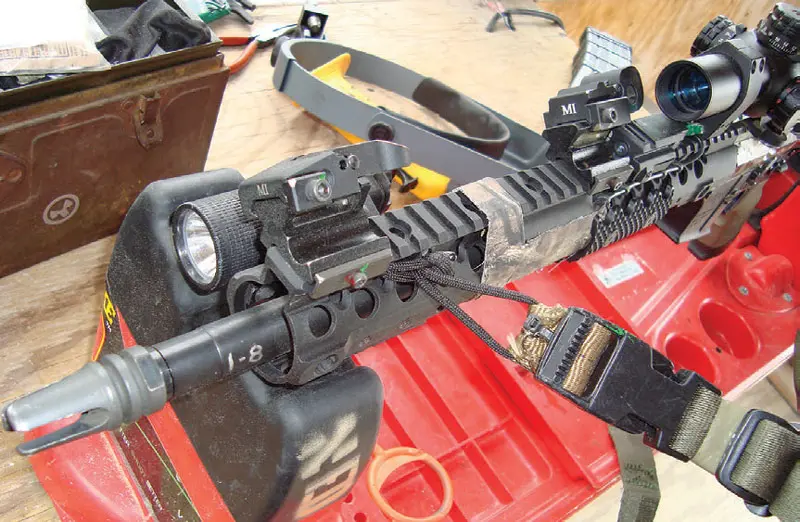
OPTICS
For glass, I used a Millett DMS-2 (1-6X), the logical next step from the DMS-1 (1-4X) that has been available for about eight years now. My two DMS-1s have given years of good service, one having gone through some hard knocks plus a year on loan in Afghanistan.
Surprisingly, the DMS-2 measures ½ inch shorter than the DMS-1. Like its predecessor, the DMS-2 has a circledot reticle, upgraded to include aiming dots for 200, 300, 400, and 500 yards, located for 5.56 ammo in a 16-inch barrel. Certainly, one’s point of impact (POI) changes with different barrels, loads and conditions, but the dots get you right in the neighborhood, right away.
To use the dots for aiming at these ranges, the scope must be set to 6X. Set to 1X, they are also useful at close range to compensate for the high lineof- sight-over-bore of the AR-15. An AR zeroed at 100 yards typically prints about two inches low at five to seven yards and 1 3/8 inches low at 25 yards. Using the 400-yard dot at five yards and the 150-yard “space” at 25 yards gave me near-perfect point of aim/point of impact coincidence at those ranges.
Using a 2032 battery, DMS scopes offer reticle illumination with 11 intensity settings. Glass connoisseurs may turn their nose up at the DMS line for not being made in Europe (China, unfortunately) but mine have been well up to the application.
There are several scopes of the type out there at up to six times the price. I’ve tried three of them and, no surprise, the glass is better, and one presumes better overall durability. But all suffered from barely lit reticles and/or first-focal-plane circle reticles that are tiny and hard to pick up at low magnification when you need them big and bright for fast targeting, and when dialed up in magnification, big enough to drive a tank through when you want a fine point of aim for something hundreds of yards out.
I don’t get free anything for saying it: I’d take a DMS-1 or -2 over any of them.
To mount the DMS-2, I courageously broke out of my LaRue comfort zone and used a Weaver SPR Mount. It is inexpensive and still gets the job done, solid, but not exactly “quick detachable.” More like, “detachable without tools, maybe,” using two thumb nuts backed up by lock nuts that tighten down over the thumb nuts.
It mounted the scope at the very rear limit of my personal eye relief range. This is no issue on 1X but gets more critical at 6X. I’d have preferred the scope another inch-and-a-half forward, but placing the mount half on the receiver and half on the forend is not ideal. I got used to the setup soon enough. My biggest complaint is too many sharp edges, but it is very affordable, and hallelujah, it’s made right here in the USA.
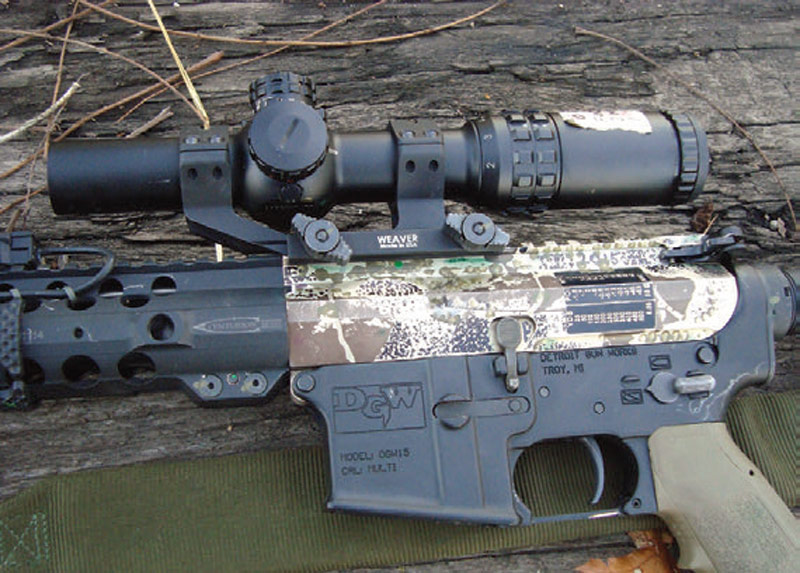
TRIGGERS
When it comes to triggers, I have become a stick-in-the-mud purist. I have seen many shooting novices who, after their very first session at the range, are asking about getting a lighter trigger to “improve” their shooting.
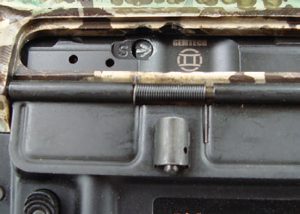
Even for experienced shooters, I don’t favor feathery aftermarket triggers for patrol rifles or anything else “serious.” Some are so light that, no matter how mechanically perfect, they can cause doubling simply by the movement of the rifle against the shoulder, bouncing the trigger back into the trigger finger. Many come up short on durability. Some have multiple adjustments that are likely to self-adjust at the wrong time. I simply have no tolerance for equipment that is unsafe or so poorly conceived that it breaks or malfunctions during or immediately after installation.
But I try to keep an open mind and occasionally test my own dogma. Certain trigger offerings in recent years have been very good on the quality and durability side, and I confess to having been tempted by them. I bought a Tactical Trigger Unit (TTU) from Wilson Combat when I discovered it was offered in several configurations. Wilson Combat
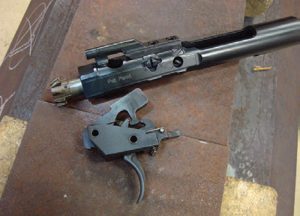
does not equivocate as to the intended use of their several models of TTU. Some are described as not being appropriate for LE applications, and I applaud them for that.
The Wilson TTU I selected was the second heaviest they offer, the H2 “Paul Howe” model, rated at 4.5 to 5 pounds. Mine breaks right in the middle. Their heaviest offering is rated at 5 to 5.5 pounds, and their lightest, intended for competition only, is rated at 3.5 to 4. Of the five models offered, three, including my H2, are two-stage. The first stage is clean and shorter than any I’ve tried. You know exactly when you’re at the second stage, which is perfectly crisp and consistent, like a good 1911 trigger. Throughout the firing of about 600 rounds and maybe an additional 100 dry-fires, there were no problems or changes in feel whatsoever.
The Trigger Puritan in me secretly enjoyed the guilty pleasure of a fine trigger pull.
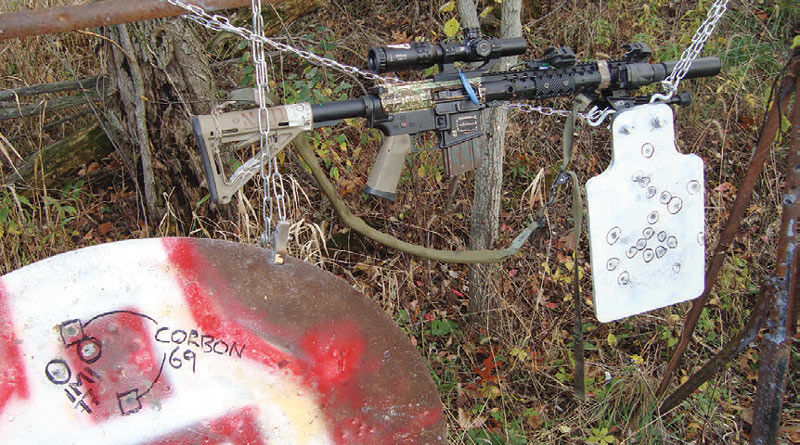
STITCHING IT TOGETHER
I used the Relia-Bolt from the Sharps Rifle Company. It departs from conventional bolt design in both material and configuration: S-7 tool steel with Robar NP3 plating is used.
Carpenter Steels information says of S-7: “air-hardening tool steel with high impact and shock resistance.” Digging deeper, one finds that the tensile and yield strengths of S-7 are greater than those of the milspec Carpenter 158.
The locking lugs are full-profile on the actual locking surfaces but reduced toward the front, the idea being that more space is available for debris where it might otherwise cause a malfunction. The “root” of each lug, where it meets the bolt body, is not reduced.
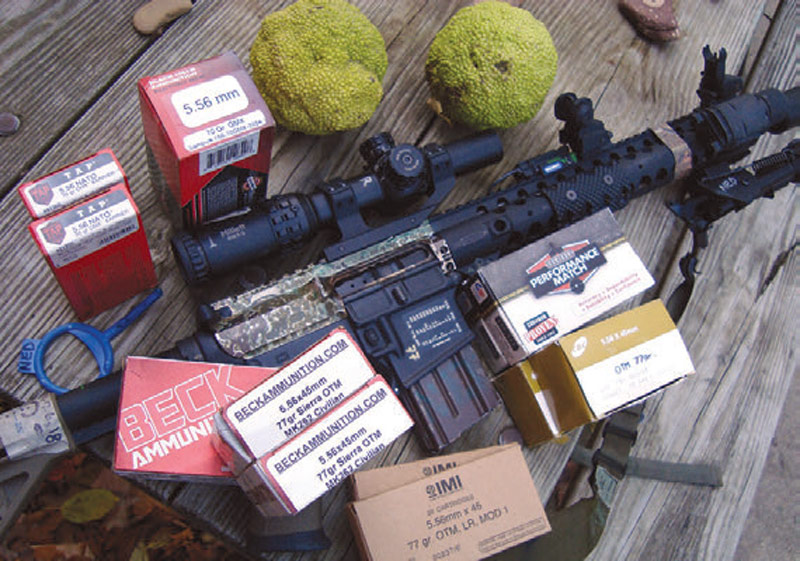
I see some merit to the idea and, having used a lot of S-7 in my tool-making days, I can attest to its qualities in that application. Is S-7 better for bolts than Carpenter 158? On paper yes, by a wide margin. But this can be truly known only after thousands of bolts survive boatloads of ammo. Mine, at 3,000 rounds in three different carbines, is not the ultimate test, but so far, so good.
The bolt carrier is something recent from Gemtech and features a “switch,” allowing the user to regulate the gas actuating the action, thus adjusting for suppressed/unsuppressed use. Selecting either setting is as easy as removing the carrier and rotating the small valve 180 degrees (a cartridge rim works). It’s a clever design and an easy, drop-in way of dealing with the additional recoil and gas-in-the-face that come with suppressing an AR-15. An arrow engraved on the valve, visible in the ejection port, shows which setting it is on.
AMMUNITION
Ammo-wise, anything with 75- to 77-grain bullets is what interests me most these days. Given a seven, eight, or sometimes nine twist, it is the best 5.56mm factory ammo bet for windresistant long-range accuracy.
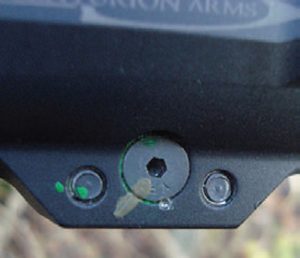
I fired six to ten groups each with IMI, Magtech, and Beck Ammunition, each using the 77-grain Sierra Match King (SMK), and with Corbon’s load using the 69-grain SMK. Finally I grouped ammo from both Hornady and Black Hills using Hornady’s GMX bullet made completely of gilding metal— the copper alloy that bullet jackets are made of.
All three of the 77-grain SMK loads tested gave one inch or smaller groups at 100 yards and all gave 2.2 inches or smaller groups at 200 yards. It’s not for nothing that the “K” in SMK stands for “King,” although in true match-grade ARs with well-tuned handloads, the SMK can do ¼ inch at 100. All three of these are duty-grade loads and one MOA is satisfactory, especially in a barrel salvaged from a blow-up.
No single group ever went over two MOA and all three 77s were neck and neck on average at about 1.3 MOA and better, with the Magtech having a slight edge.
Getting tight groups is a function of many things and is technique-intensive. My best groups are off a bench, but all the above groups were fired prone, suppressed, with a front rest or bipod and a rear sandbag to steady the stock. Given a one MOA dot reticle and a twoinch circle for a target, I was able to pretty well center the reticle, but more magnification and a finer reticle are always conducive to tighter groups.
The Corbon 69-grain SMK load seems a well-kept secret. Most people go to Corbon for butt-kicking defensive ammo, but I’ve had great accuracy from their 77-grain SMK load, and this 69-grain SMK load is no less impressive, hovering at one MOA and never exceeding 1.2 MOA.
Hornady’s GMX bullet is meant as a barrier-blind bullet, and that it is. We fired a few rounds during our semiannual FBI-protocol ballistic gel testing and found its barrier performance closely mimics the superb all-copper Barnes TSX. And it appears that GMX ammo and bullets are significantly less expensive than the Barnes counterparts.
One would think a monolithic bullet— constructed of a single piece of a single material—would have an accuracy advantage. But targets showed the GMX, in both 55 and 70 grains, again mimics the Barnes TSX in that they are just not as accurate as a boat-tailed hollow point. Groups with all GMX-topped ammo ran 1.5 to 3 MOA.
Given that the 70 grainer is longer for its weight than it would be if made of lead, I gave it a second chance in a 1:7 twist barrel, a known grouper with a 16X scope on it—and found no improvement. Not for target shooting, perhaps, but perfect for a roadblock.
I love grouping a long gun with primo ammo, but sometimes ya just gotta hear a clang. Widener’s is the main source of the IMI ammo I tested, and on their site I noticed some reasonably priced steel targets.
All loads tested had nearly the same point of impact, so on a calm day I put the Millett’s 500-yard holdover dot and the IMI, Magtech, and Corbon loads to the test on the Widener’s steel.
After a few ranging shots, I determined I could hold the 500-yard dot at dead center of the 9X12 plate and managed to hit it 26-for-30 from the roof of my vehicle. After examining the target and coming one click right, 20-for-20s became almost a gimme—until the breeze kicked up.
Time to get back out for more practice doping the wind.
